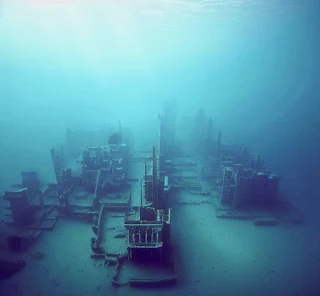Lost Underwater City of Heracleion
Heracleion is an underwater city off Egypt's coast, lost for centuries, rediscovered, revealing ancient treasures and mysteries.
Heracleion, also known as Thonis, was a significant port and trade hub in Egyptian ancient times, linking Egypt and other Mediterranean civilizations. The city's submergence is believed to be due to natural disasters and rising sea levels.
The city is believed to have sunk around 1,200 years ago. In terms of its original size, historical records and archaeological findings suggest that Heracleion was a significant port city during its time.
It is estimated to have covered an area of about 30 square kilometers or 11.6 square miles when it was above water. This would have made it a considerable city in ancient Egypt.
Situated off the coast of Egypt in the Mediterranean Sea, this submerged city remained hidden from human knowledge for centuries until its rediscovery by a team of dedicated underwater archaeologists.
Heracleion a played an important role in trading.
The city's origins can be traced back to the 8th century BCE when it served as a bustling port and a significant trade hub between Egypt and other Mediterranean civilizations. Heracleion played a pivotal role in facilitating commerce, accommodating merchants, and fostering cultural exchange.
Over time, the city grew in prominence, flourishing under Egyptian rule and later coming under the dominion of the Greeks during the Ptolemaic period. It was an important center for religious activities, boasting grand temples dedicated to various deities, including Amun and Khonsu.
Around the 2nd century BCE, Heracleion faced a series of calamitous events that eventually led to its submergence.
Historians believe a combination of natural disasters, including rising sea levels, land subsidence, and possibly earthquakes, caused the once-thriving city to sink beneath the waters of the Mediterranean.
For centuries, the existence of Heracleion was relegated to the realm of legend and myth, with tales of a sunken city capturing the imaginations of explorers and historians alike.
It wasn't until the late 20th and early 21st centuries that modern technology and improved archaeological methods enabled researchers to embark on underwater expeditions to search for this lost civilization.
The Discovery of Heracleion
In 2000, the renowned French underwater archaeologist Franck Goddio and his team finally unveiled the remarkable remains of Heracleion, lying approximately 6.5 kilometers off the coast of modern-day Alexandria, Egypt.
Since then, ongoing excavations have unearthed an astonishing array of artifacts, sculptures, and structures that provide a fascinating glimpse into the city's once-vibrant existence.
The underwater archaeological excavations at Heracleion have yielded a wealth of fascinating discoveries that provide valuable insights into the history and culture of ancient Egypt.
The submerged ruins of the city of Heracleion has been extensively explored and documented.
Archaeologists have found various structures such as temples, palaces, houses, and other buildings, giving us a glimpse into the urban layout and architecture of the ancient city.
One of the most significant discoveries was the Temple of Amun, which was a prominent religious center in the city. This temple was dedicated to the god Amun, a major deity in the Egyptian pantheon.
Numerous artifacts and statues have been found in the underwater excavation, including sculptures of Egyptian gods and pharaohs, ceremonial objects, pottery, and everyday items.
Heracleion's status as a major port city meant that there would have been numerous ships passing through or docking there. Several shipwrecks have been discovered, shedding light on ancient maritime technology and trade routes.
The discovery of offering tables, used in ancient Egyptian rituals and ceremonies, indicates the religious significance of the city.
Precious items such as jewelry, coins, and other personal belongings have been found, reflecting the wealth and prosperity of the city's inhabitants.
Archaeologists have uncovered inscriptions and stele (stone slabs) with hieroglyphic writings, providing valuable historical and religious information.
As researchers piece together the puzzle of this submerged city's history, the tale of Heracleion stands as a testament to the inexhaustible potential for unraveling the secrets of our shared past.




























